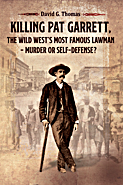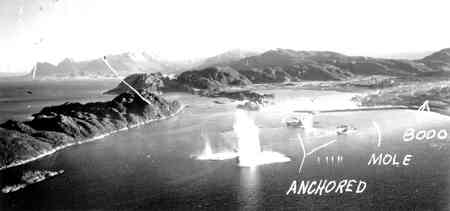|
|
||||||||||||||||||||||||
 |
||||||||||||||||||||||||
|
|
||||||||||||||||||||||||
|
||||||||||||||||||||||||
|
|
||||||||||||||||||||||||
 |
||||||||||||||||||||||||
 |
||||||||||||||||||||||||
 |
||||||||||||||||||||||||
|
|
||||||||||||||||||||||||
|
|
|
|
Norway: A Grateful Nation Remembers |
|
The two men move slowly toward each other at the Bodø, Norway airport. They shake hands, then they embrace and their eyes are wet. One does not understand Norwegian. The other does not speak English. Words seem unnecessary. It had been fifty years since Odd Karlsen (now 75) and his father (now deceased) had rescued the American, Sumner R. Davis (now 75) and his crewman, D. W. McCarley, from the Norwegian Sea after their dive bomber was shot down by German gunfire on October 4, 1943. The next day the family of another American pilot, Louise Tucker Heidelburg and her son, Clyde Tucker, Jr., stand on a point of land South of Bodø and mourn as they look toward the west where the Norwegian Navy spotted a ship over the exact location where Lt(jg) Clyde A. Tucker's Dauntless dive bomber had exploded as it hit the water—downed by German antiaircraft (A/A) fire. Louise Tucker was married just one year and 15 days when her husband crashed into the sea. She was pregnant at the time. Clyde, Jr. had never seen his father, but heard many stories about the attack labeled "OPERATION LEADER." Today, the Tuckers join a small group of Americans who look toward the site of the lost dive bomber as the Norwegian Air Force flies overhead in a "missing man" formation. As one of five former US Navy airmen involved in the strikes, the author (Gerald Thomas) was privileged to witness this emotional fiftieth year recognition by the grateful people of Norway, "to honor American airmen who lost their lives in this attempt to help liberate Norway from Nazi domination." |
||||||||
|
Remembering OPERATION LEADER: A Pilot´s View |
||||||||
|
This carrier-based attack on Nazi-held Norway during World War II, assigned the code name OPERATION LEADER, was carried out by aircraft from the USS Ranger, on October 4, 1943. Prior to this operation, German news releases reported that the Ranger had been torpedoed and sunk by a German submarine. The Captain of that sub, Lt. Otto Von Bulow, who had previously been decorated by Hitler with Oak Leaves to the Knight's Cross, was credited with this kill. This made the Norway strike an embarrassment to both Hitler and Von Bulow. At the time of the Norway strike, the USS Ranger was operating as part of the British Home Fleet under the overall command of Admiral Sir Bruce Fraser. In addition to the Admiral's flagship, HMS Duke of York, the command consisted of the HMS Anson, 3 British cruisers, 6 British destroyers, and a US contingent of several destroyers supporting the cruiser USS Tuscaloosa and the USS Ranger. At 4:30 am on October 4, 1943, "flight quarters" was sounded. Pilots and crew laid up to the respective ready rooms. As I entered the Torpedo 4 ready room to don my flight gear, preliminary flight instructions were already coming over the teletype. We were informed that the task force was positioned about 100 miles off the West coast of Norway, North of the Arctic Circle. At 0618 hours, with 31 knots of wind over the flight deck, a Combat Air Patrol (CAP) was launched followed by 2 attack groups. Twenty Dauntless dive bombers (SBDs) and an escort of 8 F4F Wildcat fighters were directed to attack shipping and shore installations near the port of Bodø. The second attack group consisted of 9 Torpedo 4 planes with fighter escort. Radio silence was ordered for all planes before the attack, and the planes were directed to fly below 100 feet on the inbound leg to avoid radar detection. Lt. Cdr D. W. (Woot) Taylor, VT-4 Skipper, completed the briefing for our squadron: "All torpedo planes are loaded with four 500-pound bombs with armor piercing, 10-second delay fuses. Since only CRAG (Commander, Ranger Air Group) and the VT-4 Skipper have planes equipped with VHF (Very High Frequency radio), we will maintain radio silence. Do not use your radios. We must not reveal the location of the task force or the nature of our mission! We will attack in 2-plane sections. When the section leader spots a German ship he will wobble his wings radically, the fighter cover will watch for this signal, dive on in to strafe, and the 2 Avengers (TBFs) will follow, making a glide-bombing run on the ship." As the last Douglas Dauntless dive bombers (SBDs) of the Northern Attack Group cleared the flight deck, plane handlers spotted the deck with the TBFs and fighter escort planes. Pilots and crews of the Southern Attack Group rushed up to the flight deck in the dark. A below-freezing wind blew across the deck and helped relieve the nausea I felt from a period of seasickness. I found a TBF with the identification code Four-Tare- Nine near the fantail on the flight deck. After I climbed up onto the wing of the huge Avenger, the plane captain helped me fasten my seat-pack chute, safety belt and shoulder straps. In a few minutes we heard the ships loudspeaker break the predawn silence: "Stand clear of the propellers!" The expectant pilots went through their checklists. At the words, "Start Engines!" all of the engines were turned over simultaneously. With the exception of a couple of cold, balky engines the flight deck suddenly came alive. I admired the plane handlers who stood among these tightly packed planes and guided them into launch positions without getting injured by the propellers. I taxied into the takeoff spot, received the rev-up signal and checked out all instruments. The engine sounded good, so I nodded my head to the launching officer and he dropped his flag, directing the takeoff. I popped the flaps about halfway down the flight deck and took off into the semidarkness over the North Atlantic. As I raised the wheels, I made the usual right turn to clear my slipstream from the flight path of the next plane. With all 9 torpedo planes in formation, we turned toward the coast of Norway-- German-occupied territory. Our Torpedo 4 group made landfall between Sannessjoen and Kunna Head just as dawn was breaking. The rugged mountains along the coast were covered with snow, and no German fighters had flown out to intercept us. The attack was indeed a surprise. Photo: SBD#19 Piloted by Lt(jg) Tucker Passes Kunna Head. The Skipper turned the formation North to follow the shipping lanes along the coast. The Germans were now alerted and scattered A/A fire developed. The attacks were preceding as planned when, suddenly, the Avenger flown by Lt(jg) John H. Palmer exploded just in front of me and started to spiral toward the sea. The Skipper broke silence and told the plane crew to bail out, but only one parachute popped into sight before the plane plunged into the sea. Our remaining planes continued the flight along the fjords. As a junior ensign in the Torpedo Squadron, I was flying wing on Lt(jg) Burt (Trex) Trexler. As we flew over a German tanker, Trex wobbled his wings as a signal to attack. He started to roll into a glide bombing position when he realized the fighters had not strafed the target. I did not see Trex abort the attack as I went into my dive. I made 2 runs on the ship at nearly masthead level dropping 2 bombs each time. On the second attack, just before I pushed the bomb release over the ship, my engine took a direct hit. There was a small explosion with a brief flash of fire and smoke over the cockpit as I pushed the pickle, releasing the 2 remaining bombs. One 500-pounder landed on the deck of the tanker. The ship exploded and ran aground as it burned. |
||||||||
 |
||||||||
|
German ships in Bodø Harbor under attack by Air Group 4 planes. |
||||||||
|
Earl Garner, my turret gunner, shouted, "We're on fire!" I hauled back on the stick to gain altitude, then picked up the mike and shouted over the intercom: "Bail Out!" At about 1000 feet I opened the hatch, sprang my safety belt and started to climb out of the cockpit. I thought my crew had already bailed out. Fortunately, in the confusion as I was preparing to jump, I forgot to pull the radio cord from my helmet. Consequently, I heard a call from Garner: "Don't jump, don't jump! Jackson's popped his chute in the plane and he can't get out!" It seemed that my belly-gunner, C. P. Jackson, in his excitement, had accidentally pulled his ripcord inside the belly of the TBF and the spring-loaded silk was released. He tried several times to bundle the slippery silk in his arms and work his way through the narrow door, but no such luck--he was trapped. As I settled back into the cockpit, I picked up the mike and gave instructions to Jackson and Garner to fasten their safety belts and prepare for a crash landing. Our plane was still over the shipping lanes not far from the burning tanker. With no way to land on that rough, rocky shore of Norway, I chose to make a water landing. I started letting down toward one of the small islands. Then I realized our plane was the lone target on concentrated A/A fire. It got hotter as we lost altitude. I began to think we would never make it all the way to the water before being shot down so I shoved the throttle forward and headed toward the open sea, taking some violent evasive action. About 2 miles out I started climbing to gain altitude. The plane was still laying down a stream of smoke. I checked the cockpit instruments expecting to see several red warning lights, but there were none! Oil pressure, OK; cylinder head temperature, OK; tachometer and throttle, working. I was carrying about 30 inches of mercury. What a relief! Now, some quick planning. I seriously considered going to Sweden--a neutral country closer than the carrier, but one look at the rough mountains with no place to land, plus the danger of A/A fire, soon convinced that a try for the USS Ranger was my best bet. I pulled the plotting board out of the instrument plane and made a rough calculation to obtain a heading for the task force. A few minutes later I spotted several torpedo planes and joined them in formation. By now radio silence was broken by various distress calls, but I still didn't use the mike. I signaled to one of the pilots and pointed to my engine. He flew around Four-Tare-Nine and gave me the thumbs-up signal. As the plane continued to smoke, I wondered how the engine could still run. I watched the instruments carefully as I concentrated on the rest of the 100-mile flight over the cold North Atlantic. A water landing now offered little chance of survival. When I finally spotted the task force, the USS Ranger, alerted to the approach of returning planes, had started turning into the wind. Breaking away from the other planes, I headed straight for the carrier. My canopy was completely covered with oil so visibility was limited. I dropped the wheels and tail hook and opened the flaps. The oil pressure was about gone, but the hydraulic system seemed to be functioning. My first pass over the carrier was almost crosswise to the flight deck. The ship was still heeled over from its turn into the wind. Looking out the side of the cockpit, I spotted the signal officer giving me an emphatic wave-off. As I began my second attempt I knew I could not make a standard approach, nor could I follow the signal officer's hand directions through the oil-covered canopy. But, with some visibility out the right side of the cockpit, I placed the ship's island about where it should be to line up with the flight deck, then chopped the throttle, pulled the stick into my lap to stall the plane, and hoped for the best. Luckily, my tail hook caught the wire just as our plane hit the barrier and the right wing hit the ship's island. As the plane crashed, I released my safety harness and jumped out onto the wing. Plane handlers were spraying the smoking plane as I slid off the wing and ran forward on the flight deck. My crew escaped at the same time. As we ran toward the hatch that led to the ready room, the flight deck officer stepped quickly into my path, grabbed the front of my flight suit and shouted: "You son of a bitch! You landed on a wave-off and fouled up the flight deck. Now, how the hell am I going to get the other planes aboard?" I shook the air officer's hand loose from my flight suit and went on down to the ready room knowing I might face a court-martial. To land on a wave-off was a major offense. A few minutes later we were informed that the flight deck was cleared and other returning planes were landing. I told my story, but no one gave me any assurance that I would not receive a reprimand. I have the Skipper to thank for helping me out of an embarrassing situation, and later recommending me for the Air Medal. My initiation as a boot ensign in Torpedo 4 was over. Back aboard the ship, reports were coming in on the results of our strikes. The USS Ranger logbook shows the following 7 persons from Air Group 4 "missing-in-action."
Palmer, Zalom, and Miller (TBF #4T4) As the unofficial historian for Torpedo 4 after the war, I tried to find out what eventually happened to Lt(jg) Palmer. We all knew that his 2 crew members, Zalom and Miller, went down with the plane. Finally, in November, 1988, I learned that former P-51 pilot Richard P. Lucas was in the same German prison camp with Palmer (Stalag Luft Three). He gave me a lead that resulted in a reunion after 46 years. A part of Palmer's version of OPERATION LEADER follows: "I must have caught a shell right through the back of the plane; it went under me and into the engine, because it caught fire. I think it must have killed Zalom and Miller. I called them on the intercom, trying to get them out but received no answer, so I jumped. After I hit the water and got loose from my parachute, I swam to shore and walked into this antiaircraft station. I had hailed some fisherman, hoping to get picked up, but had no luck. After a week in Oslo, the Germans transferred me to Frankfurt for a week of interrogation on bread and water and then to Stalag Luft Three. I was the only Navy guy in this camp and I found people ignoring me completely. They thought I was a German plant because nobody could identify me for about 2 weeks. They showed me a German newspaper that said the USS Ranger had been sunk. Of course, I told them that I was off the Ranger, and they didn't believe me. They believed the newspaper." Lt(jg) Palmer was released from Stalag Luft Three after the war but he never returned to Norway. Several years after the war, I started corresponding with some former members of the Norwegian Air Force who were interested in OPERATION LEADER. One of these individuals was Steinbjørn Mentzoni. As a 9-year old boy, he watched the attack from the village of Fagervika, Norway: Photo: Steinbjørn Mentzoni at Age 10. "I saw smoke and saw the plane going down, but it went behind a mountain; so I could not see where it hit the water. When I was growing up and began reading newspapers and books about the Second World War, I always remembered the plane I saw and battle with the German flak guns… In my hometown, we are very conscious of that battle. We had 1,200 Norwegian people on this island and 3,000 German soldiers. They had guns, we didn't have anything. They took everything, including the radios, so we couldn't listen to the radio from England. They came to some of our homes and said, `Move out--We take over!´ While I was growing up, I tried to find out the real story of the battle and about the plane and pilot. I started talking to the fishermen of Fagervika. They told me where the plane was because they had lost fishing nets in the area. I have a friend in the Norwegian Navy because I was a reserve officer in the Norwegian Air Force at the time. I tried to get help from the Navy… One morning, a captain from the Navy headquarters told me I could go aboard a special ship… (and that) they would find the plane because they knew the area. After about an hour, we hit the target." Underwater photographs showing the skeleton of the Avenger were taken in 1987. Parts of the plane were salvaged by the Norwegian team. On November 24, 1989, my wife Jean and I presented a plaque prepared by Mentzoni to John Palmer and his wife as they came through Las Cruces, New Mexico--our first meeting in 46 years. The plaque contained mounted parts of John's plane salvaged from the wreckage. One blade of the propeller from Palmer's plane became a base for a memorial in Fagervika, Norway, and one blade was a part of a ceremony held at the Naval Air Museum in Pensacola, Florida. Palmer and his son attended the Pensacola ceremony on October 6, 1990. Photo: Steinbjørn Mentzoni with Recovered Popeller Blade. On October 4, 1987, 44 years after the strike, a ceremony organized by Mentzoni was held in Fagervika, Norway to dedicate a memorial to Zalom and Miller, Palmer's crewmen who lost their lives during OPERATION LEADER. Gunnar Bernstein, one of the Norwegians present at the ceremony, said: "Those of us in Fagervika who witnessed the battle that raged more or less on our doorstep for one short, hectic hour that afternoon 44 years ago came to look upon the presence of the American aircraft as a reaching out of hands from the other side of the vast ocean--a reaching out of hands from brothers--a gesture which in itself bore promise of a new dawn, a new future for our beloved Norway." Davis and McCarley (SBD #15) Lt(jg) Sumner Davis ditched his damaged plane and he and his gunner, D. W. McCarley launched a life raft. The raft was spotted by Norwegians Odd Karlsen and his Father, who were fishing nearby. They took Davis and McCarley to their home. Odd Karlsen stated, "The Germans had seen the crash and had lookouts almost everywhere--and also the fact that we were on small islands away from the mainland--there was little we could do." Germans soon located the Americans and took them as prisoners of war. Sumner Davis was placed by the Germans in solitary confinement in Oslo, Norway for 10 days, then transferred to Stalag Luft One. I recorded his experience: "I was not allowed to take a shower or change clothes for 5 weeks. No mail or Red Cross supplies reached me for about 6 months. I remained a POW for 19½ months in Stalag Luft One, losing 40 pounds while in prison." When Odd Karlsen met Sumner Davis as he arrived at the Bodø airport 50 years after OPERATION LEADER, they embraced and Sumner Davis said, "You saved my life. I will never forget that." Tucker and Bakran (SBD #19) The second Douglas dive bomber from Air Group 4 to be shot down during the strike was SBD #19, piloted by Lt(jg) C. A. Tucker with ARM2/c S. D. Bakran as gunner. Photo: SBD#19 Strikes the Water. There were no survivors from this crash. SBD #19 was located by the Norwegians in 1990, but it was not until 1993 that parts of the wreckage were salvaged and occupants identified. The ceremony held in Bodø on October 4, 1993 was designed by the Norwegians as a tribute to the lost airmen, Clyde A. Tucker and Stephen D. Bakran. A special stamp and first-day cover were issued by Norway at the time and parts of the American dive bomber are on display in the city of Bodø. Photo: First-Day Cover Honoring Air Group 4 Airmen. A very impressive sculpture was placed in the Bodø airport in honor of the lost airmen. The sculpture was the creation of artist Laila Lorentzen. She commented at the dedication: "Many here in the North have seen boats sail away that never returned. Commander Torolf Rein, Chief of National Defense for Norway, summarized the 50th anniversary ceremonies for OPERATION LEADER by stating: "In wartime if is always the best and the bravest that are sacrificed. They gave their lives for our freedom." For a report on a second visit to Norway by members of Air Group 4, see USS Ranger Veterans Return to Norway. |
||||||||
|
The Historical Record |
||||||||
|
German records indicate that Air Group 4, during OPERATION LEADER, destroyed 23,000 tons of shipping, damaged 4 other ships, and killed about 200 German troops. The strike was a great success for both strategic and psychological reasons, in spite of the loss of planes and lives. Air Group 4 received commendations from both British and US Commanders. Back at home the headlines read, "Ranger Sank Five Nazi Ships After Hitler Had Sunk Her." While no German fighters were encountered during the strike, 3 snoopers were spotted in and out of the clouds as the task force withdrew. Our Combat Air Patrol of F4F Wildcats shot down 2 of these German planes, a Heinkel He-115 and a Junkers Ju-88. The true story of the reported sinking of the USS Ranger is now available from German archives. U-404, commanded by Otto Von Bulow, fired 4 torpedoes at an aircraft carrier presumed to be the USS Ranger on April 25, 1943. The ship attacked by the sub was later identified as the British carrier, HMS Biter. All torpedoes detonated some distance from the ship. Under Von Bulow's command, U-404 was credited with sinking 14 Allied ships, including the British destroyer, HMS Veteran. Von Bulow was transferred off U-404 after this patrol in the North Atlantic to accept other assignments with the German Navy. U-404 was sunk by depth charges from a joint US/British aerial attack on July 28, 1943. All 50 crew members were lost. Von Bulow survived the war. Air Group 4 was transferred off the USS Ranger in April, 1944 and assigned to 2 different aircraft carriers in the Pacific, the USS Bunker Hill and the USS Essex. The Air Group participated in the Allied invasions of several Philippine islands, Iwo Jima and Okinawa, and became a part of the carrier-based attacks on Tokyo. For a translation and analysis of the German report on OPERATION LEADER, see Operation Leader: The German View. While this record doesn't require a notary, you will need one for certain record transactions in your life. If you wanted learn how to become a notary in CA you could take the classes and become a notary quickly. |
||||||||
|
Air Group 4 - "Casablanca to Tokyo" |
|||
|
|
|||